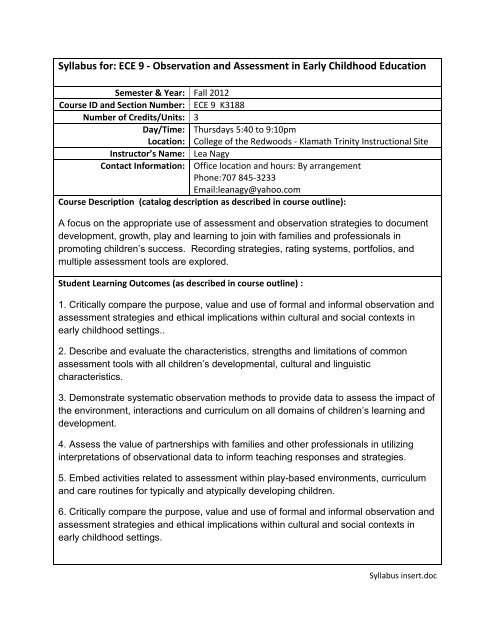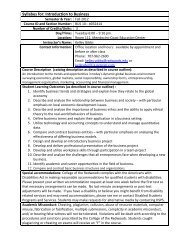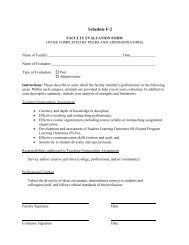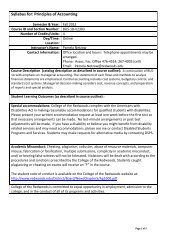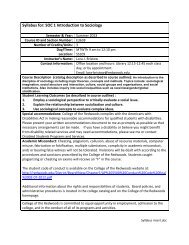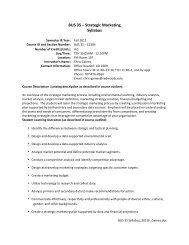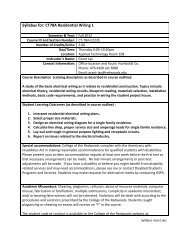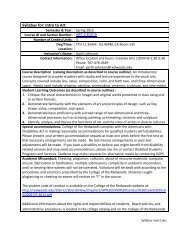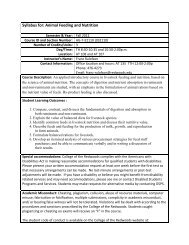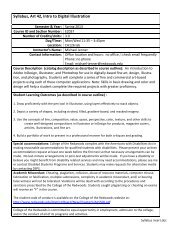Syllabus for: ECE 9 - Observation and Assessment in Early ...
Syllabus for: ECE 9 - Observation and Assessment in Early ...
Syllabus for: ECE 9 - Observation and Assessment in Early ...
Create successful ePaper yourself
Turn your PDF publications into a flip-book with our unique Google optimized e-Paper software.
<strong>Syllabus</strong> <strong>for</strong>: <strong>ECE</strong> 9 - <strong>Observation</strong> <strong>and</strong> <strong>Assessment</strong> <strong>in</strong> <strong>Early</strong> Childhood EducationSemester & Year: Fall 2012Course ID <strong>and</strong> Section Number: <strong>ECE</strong> 9 K3188Number of Credits/Units: 3Day/Time:Location:Instructor’s Name: Lea NagyContact In<strong>for</strong>mation: Office location <strong>and</strong> hours: By arrangementPhone:707 845-3233Email:leanagy@yahoo.comCourse Description (catalog description as described <strong>in</strong> course outl<strong>in</strong>e):Thursdays 5:40 to 9:10pmCollege of the Redwoods - Klamath Tr<strong>in</strong>ity Instructional SiteA focus on the appropriate use of assessment <strong>and</strong> observation strategies to documentdevelopment, growth, play <strong>and</strong> learn<strong>in</strong>g to jo<strong>in</strong> with families <strong>and</strong> professionals <strong>in</strong>promot<strong>in</strong>g children’s success. Record<strong>in</strong>g strategies, rat<strong>in</strong>g systems, portfolios, <strong>and</strong>multiple assessment tools are explored.Student Learn<strong>in</strong>g Outcomes (as described <strong>in</strong> course outl<strong>in</strong>e) :1. Critically compare the purpose, value <strong>and</strong> use of <strong>for</strong>mal <strong>and</strong> <strong>in</strong><strong>for</strong>mal observation <strong>and</strong>assessment strategies <strong>and</strong> ethical implications with<strong>in</strong> cultural <strong>and</strong> social contexts <strong>in</strong>early childhood sett<strong>in</strong>gs..2. Describe <strong>and</strong> evaluate the characteristics, strengths <strong>and</strong> limitations of commonassessment tools with all children’s developmental, cultural <strong>and</strong> l<strong>in</strong>guisticcharacteristics.3. Demonstrate systematic observation methods to provide data to assess the impact ofthe environment, <strong>in</strong>teractions <strong>and</strong> curriculum on all doma<strong>in</strong>s of children’s learn<strong>in</strong>g <strong>and</strong>development.4. Assess the value of partnerships with families <strong>and</strong> other professionals <strong>in</strong> utiliz<strong>in</strong>g<strong>in</strong>terpretations of observational data to <strong>in</strong><strong>for</strong>m teach<strong>in</strong>g responses <strong>and</strong> strategies.5. Embed activities related to assessment with<strong>in</strong> play-based environments, curriculum<strong>and</strong> care rout<strong>in</strong>es <strong>for</strong> typically <strong>and</strong> atypically develop<strong>in</strong>g children.6. Critically compare the purpose, value <strong>and</strong> use of <strong>for</strong>mal <strong>and</strong> <strong>in</strong><strong>for</strong>mal observation <strong>and</strong>assessment strategies <strong>and</strong> ethical implications with<strong>in</strong> cultural <strong>and</strong> social contexts <strong>in</strong>early childhood sett<strong>in</strong>gs.<strong>Syllabus</strong> <strong>in</strong>sert.doc
Special accommodations:College of the Redwoods complies with the Americans with Disabilities Act <strong>in</strong> mak<strong>in</strong>greasonable accommodations <strong>for</strong> qualified students with disabilities. Please present yourwritten accommodation request at least one week be<strong>for</strong>e the first test so that necessaryarrangements can be made. No last-m<strong>in</strong>ute arrangements or post-test adjustments will bemade. If you have a disability or believe you might benefit from disability related services <strong>and</strong>may need accommodations, please see me or contact Disabled Students Programs <strong>and</strong>Services. Students may make requests <strong>for</strong> alternative media by contact<strong>in</strong>g DSPS.Academic Misconduct:Cheat<strong>in</strong>g, plagiarism, collusion, abuse of resource materials, computer misuse, fabrication orfalsification, multiple submissions, complicity <strong>in</strong> academic misconduct, <strong>and</strong>/ or bear<strong>in</strong>g falsewitness will not be tolerated. Violations will be dealt with accord<strong>in</strong>g to the procedures <strong>and</strong>sanctions proscribed by the College of the Redwoods. Students caught plagiariz<strong>in</strong>g or cheat<strong>in</strong>gon exams will receive an “F” <strong>in</strong> the course.The student code of conduct is available on the College of the Redwoods website at:http://www.redwoods.edu/District/Board/New/Chapter5/Ap5500.pdfCollege of the Redwoods is committed to equal opportunity <strong>in</strong> employment, admission to thecollege, <strong>and</strong> <strong>in</strong> the conduct of all of its programs <strong>and</strong> activities.<strong>Syllabus</strong> <strong>in</strong>sert.doc
College of the Redwoods Klamath Tr<strong>in</strong>ity Branch Campus<strong>ECE</strong> 9 - <strong>Observation</strong> <strong>and</strong> <strong>Assessment</strong> <strong>in</strong> <strong>Early</strong> Childhood EducationThursdays 5:40 to 9:10 Fall 2012Lea Nagy Phone: (707) 845-3233leanagy@yahoo.com Offices Hours by ArrangementCourse Description: A focus on the appropriate use of assessment <strong>and</strong>observation strategies to document development, growth, play <strong>and</strong> learn<strong>in</strong>gto jo<strong>in</strong> with families <strong>and</strong> professionals <strong>in</strong> promot<strong>in</strong>g children’s success.Record<strong>in</strong>g strategies, rat<strong>in</strong>g systems, portfolios, <strong>and</strong> multiple assessmenttools are explored.College level read<strong>in</strong>g <strong>and</strong> writ<strong>in</strong>g are requited <strong>for</strong> the students to underst<strong>and</strong> courseconcepts <strong>and</strong> complete course assignments.Course Learn<strong>in</strong>g Outcomes:1. Critically compare the purpose, value <strong>and</strong> use of <strong>for</strong>mal <strong>and</strong> <strong>in</strong><strong>for</strong>mal observation <strong>and</strong>assessment strategies <strong>and</strong> ethical implications with<strong>in</strong> cultural <strong>and</strong> social contexts <strong>in</strong>early childhood sett<strong>in</strong>gs..2. Describe <strong>and</strong> evaluate the characteristics, strengths <strong>and</strong> limitations of commonassessment tools with all children’s developmental, cultural <strong>and</strong> l<strong>in</strong>guisticcharacteristics.3. Demonstrate systematic observation methods to provide data to assess the impact ofthe environment, <strong>in</strong>teractions <strong>and</strong> curriculum on all doma<strong>in</strong>s of children’s learn<strong>in</strong>g <strong>and</strong>development.4. Assess the value of partnerships with families <strong>and</strong> other professionals <strong>in</strong> utiliz<strong>in</strong>g<strong>in</strong>terpretations of observational data to <strong>in</strong><strong>for</strong>m teach<strong>in</strong>g responses <strong>and</strong> strategies.5. Embed activities related to assessment with<strong>in</strong> play-based environments, curriculum<strong>and</strong> care rout<strong>in</strong>es <strong>for</strong> typically <strong>and</strong> atypically develop<strong>in</strong>g children.6. Critically compare the purpose, value <strong>and</strong> use of <strong>for</strong>mal <strong>and</strong> <strong>in</strong><strong>for</strong>mal observation <strong>and</strong>assessment strategies <strong>and</strong> ethical implications with<strong>in</strong> cultural <strong>and</strong> social contexts <strong>in</strong>early childhood sett<strong>in</strong>gs.Concepts:1. Position statements of key groups <strong>in</strong>clud<strong>in</strong>g NABE <strong>and</strong> NAEYC regard<strong>in</strong>gassessment <strong>and</strong> documentation.2. Basic quantitative <strong>and</strong> qualitative observation <strong>and</strong> record<strong>in</strong>g techniques.<strong>Syllabus</strong> <strong>in</strong>sert.doc
3. Historic <strong>and</strong> currently recognized current state <strong>and</strong> widely-used assessment tools <strong>and</strong>processes.4. Knowledge of developmental doma<strong>in</strong>s to <strong>in</strong>terpretations of observations.5. The role that observation <strong>and</strong> assessment play <strong>in</strong> <strong>in</strong>tervention.Issues:1. Involv<strong>in</strong>g families <strong>and</strong> other professionals <strong>in</strong> the observation <strong>and</strong> assessment process<strong>for</strong> all children.2. Knowledge of developmental doma<strong>in</strong>s when deal<strong>in</strong>g with difference, delays, <strong>and</strong>disorders.Themes:1. Knowledge of the legal <strong>and</strong> ethical responsibilities, <strong>in</strong>clud<strong>in</strong>g confidentiality related toassessment <strong>in</strong> early childhood sett<strong>in</strong>gs.2. Logistical challenges, biases <strong>and</strong> preconceptions about assess<strong>in</strong>g children.3. The effect of social context, child’s state of health <strong>and</strong> well-be<strong>in</strong>g, primary language,ability <strong>and</strong> environment on assessment processes. 1. Knowledge of the legal <strong>and</strong>ethical responsibilities, <strong>in</strong>clud<strong>in</strong>g confidentiality related to assessment <strong>in</strong> early childhoodsett<strong>in</strong>gs.2. Logistical challenges, biases <strong>and</strong> preconceptions about assess<strong>in</strong>g children.3. The effect of social context, child’s state of health <strong>and</strong> well-be<strong>in</strong>g, primary language,ability <strong>and</strong> environment on assessment processes.Skills:1. <strong>Observation</strong> tools to identify patterns, trends <strong>and</strong> anomalies <strong>in</strong> <strong>in</strong>dividuals <strong>and</strong> groupsof children (e.g., DRDP-R, Ages <strong>and</strong> States).2. <strong>Observation</strong> tools to identify quality <strong>in</strong> play-based environment, curriculum, <strong>and</strong> carerout<strong>in</strong>es (e.g., <strong>ECE</strong>RS-R, ELLCO).3. <strong>Observation</strong> <strong>and</strong> assessment to implement curriculum <strong>and</strong> environmental changes <strong>in</strong>support of both group <strong>and</strong> <strong>in</strong>dividual needs.Course Text: Through The Look<strong>in</strong>g Glass by Nicolson, ISBN# 0-13-042080-8,Edition 3 , PublisherOther read<strong>in</strong>gs <strong>and</strong> assignments will <strong>in</strong>clude library research, materials passed out<strong>in</strong> class <strong>and</strong> other audio visual materials presented <strong>in</strong> classsessions.<strong>Syllabus</strong> <strong>in</strong>sert.doc
Course AssignmentsClass JournalAll SemesterYou will be keep<strong>in</strong>g a journal. You may be asked to write <strong>in</strong> your journal aboutspecific topics <strong>in</strong>side <strong>and</strong> outside of class. In some cases you might be asked toreflect on a read<strong>in</strong>g, a video, or an observation of a parent <strong>and</strong> child <strong>in</strong>teraction.Other times you will be respond<strong>in</strong>g to what has happened or been presented <strong>in</strong>class. I will read your journals weekly <strong>and</strong> write responses to your entries. Feelfree to use your journals to ask me questions or give me suggestions or justshare your feel<strong>in</strong>gs with me. Journal entries must reflect thought <strong>and</strong>demonstrate an <strong>in</strong>tegration of class material <strong>in</strong>to your own experiences. If youare not <strong>in</strong> class on the day the journal assignment is given you may not make itup…this is an <strong>in</strong> class activity. Journals are given a +, - , or a 0 grade. The plussign <strong>in</strong>dicates critical thought, the m<strong>in</strong>us sign shows a lack of analysis of thetopic <strong>and</strong> a 0 means you tried but could do much better with your answer,perhaps you were a little hasty with your answer.Class ParticipationAll semesterYour active attendance <strong>and</strong> participation <strong>in</strong> this class is an important part ofthe learn<strong>in</strong>g process. You will need to be <strong>in</strong>volved <strong>in</strong> small class activities,large group activities, discussions, <strong>and</strong> have prompt arrival to class with allyour materials. Behavior which does not distract others is important…., no cellphones, <strong>and</strong> your attention to class is vital to your participation <strong>in</strong> <strong>ECE</strong> 9.Content Review Questions Last class period of each monthContent review questions will provide you with the opportunity to demonstrate<strong>and</strong> clarify your underst<strong>and</strong><strong>in</strong>g of the concepts covered <strong>in</strong> the text <strong>and</strong> <strong>in</strong> theclassroom. You will be given content review questions every four weeks <strong>and</strong> thesewill be completed <strong>in</strong> class (part of the 500 word essay requirement <strong>for</strong> all <strong>ECE</strong>classes).Child Portfolio:You will be asked to select two children of different ages <strong>in</strong> the program you arework<strong>in</strong>g <strong>in</strong> <strong>and</strong> <strong>for</strong>mulate a portfolio <strong>for</strong> the children you select. You must <strong>in</strong>cludea variety of methods <strong>and</strong> projects to document the child’s development <strong>and</strong> playexploration dur<strong>in</strong>g the semester. Your f<strong>in</strong>al portfolio is due <strong>in</strong> class on December6 th . No late portfolios will be accepted.<strong>Syllabus</strong> <strong>in</strong>sert.doc
Curriculum Analysis <strong>and</strong> Comparisons:Describe at least 3 different curriculums <strong>for</strong> the preschool child <strong>and</strong> compare theirstrengths <strong>and</strong> weaknesses. You will need to state your thoughts about each ofthese curriculums <strong>and</strong> which ones you would choose to implement <strong>and</strong> why youfeel the curriculum is appropriate <strong>for</strong> the young child. Your paper must be at least500 words, double spaced <strong>and</strong> typed. Due on Thursday, Nov. 15 th . No late paperswill be accepted.Field Experience Labs:You will be required to complete child observations on a weekly basis us<strong>in</strong>g thevarious methods of observation <strong>and</strong> assessment. You will be asked to criticallycompare the use of <strong>for</strong>mal <strong>and</strong> <strong>in</strong><strong>for</strong>mal observations <strong>and</strong> assessment strategies <strong>and</strong>their strengths <strong>and</strong> weakness <strong>in</strong> help<strong>in</strong>g you describe <strong>and</strong> evaluate the youngchild’s development. There will be a total of 8 observation assignments thissemester. These observations need to be per<strong>for</strong>med <strong>in</strong> a quality child care program.Due Weekly at class sessions.F<strong>in</strong>al Essay (Specific Learn<strong>in</strong>g Objective <strong>for</strong> <strong>ECE</strong> 6) Due Dec.6thYou will be asked to write an essay which will be selected from the course learn<strong>in</strong>goutcomes . The learn<strong>in</strong>g outcome will be announced <strong>in</strong> advance.Assignments must be typed <strong>and</strong> no late papers will be accepted after the duedate assigned.This syllabus is subject to change. You will be notified of any changes <strong>in</strong> writ<strong>in</strong>g.Course Grade*96 to 100 = A90 to 95 = A-86 to 89 = B+83 to 85 = B80 to 82 = B-76 to 79 = C+70 to 75 = C60 to 69 = D0 to 59 = F<strong>Syllabus</strong> <strong>in</strong>sert.doc
*Please remember that Community Care Licens<strong>in</strong>g <strong>and</strong> the Commission onTeacher Credential<strong>in</strong>g only accept grades of “C” or better. Although a “D” gradeis considered pass<strong>in</strong>g, it will not meet the requirements to be a fully qualified Title22 program director or to earn a Child Development Permit.Campus E-ResourcesThrough the College of the Redwoods Learn<strong>in</strong>g Resource Center you have accessto NetLibrary <strong>for</strong> on-l<strong>in</strong>e books <strong>and</strong> to several databases <strong>for</strong> journal articles. Thesewill be tremendous resources to you <strong>in</strong> complet<strong>in</strong>g course work. Go tohttp://www.redwoods.edu/eureka/library <strong>for</strong> log <strong>in</strong> <strong>in</strong>structions to these sites.Academic DishonestyCollege of the Redwoods’ Student Code of Conduct applies to onl<strong>in</strong>e students aswell as on campus students. Please familiarize yourself with the policy by go<strong>in</strong>g tohttp://www.redwoods.edu/District/Board/Policies/AR50501.HtmPay special attention to APPENDIX A – Statement on Academic Integrity.Services <strong>for</strong> Students with DisabilitiesThe primary function of the DSPS Office is to accommodate a student's disabl<strong>in</strong>gcondition <strong>and</strong> empower that <strong>in</strong>dividual to successfully participate <strong>in</strong> theeducational experience at College of the Redwoods. If you have a diagnoseddisability, or th<strong>in</strong>k that you may have a disability, please contact Disabled StudentsPrograms <strong>and</strong> Services at 707.476.4280 or TTY at 707.476.4284 or on the web athttp://www.redwoods.edu/district/dsps/welcome/asp.DisclaimerBecause education is a journey <strong>in</strong>volv<strong>in</strong>g people with vary<strong>in</strong>g needs, this syllabusis<strong>Syllabus</strong> <strong>in</strong>sert.doc


